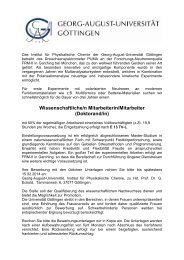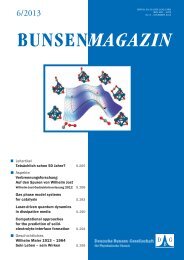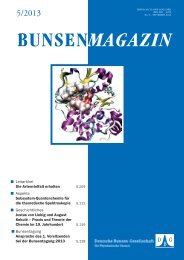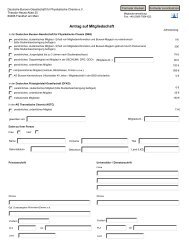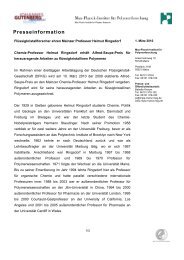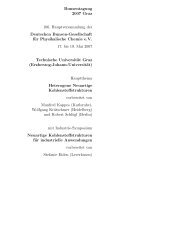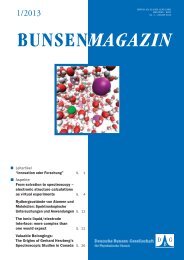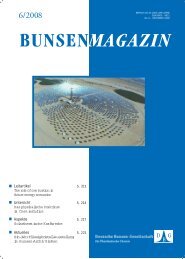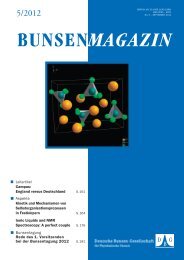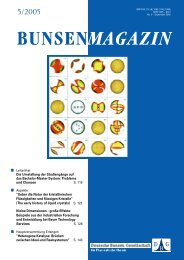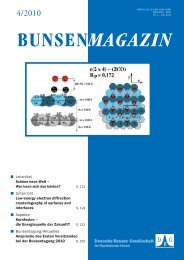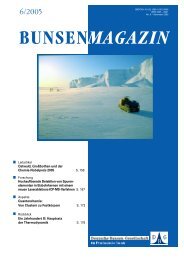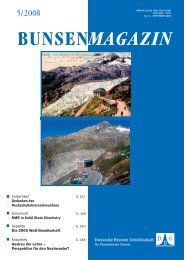BUNSENMAGAZIN - Deutsche Bunsengesellschaft für ...
BUNSENMAGAZIN - Deutsche Bunsengesellschaft für ...
BUNSENMAGAZIN - Deutsche Bunsengesellschaft für ...
Erfolgreiche ePaper selbst erstellen
Machen Sie aus Ihren PDF Publikationen ein blätterbares Flipbook mit unserer einzigartigen Google optimierten e-Paper Software.
UNTERRICHT<br />
there is currently much interest in polycyclic<br />
aromatic materials, which form<br />
columnar mesophases, 70 on account<br />
of, for example, their potential applications<br />
as charge transport layers in<br />
devices such as fi eld-effect transistors,<br />
photovoltaic cells, and light-emitting diodes.<br />
71 One such class of materials is<br />
comprised of hexa-peri-hexabenzocoronenes<br />
(HBCs), which have high one dimensional<br />
charge carrier mobility along<br />
the columns. 72 In order to control and<br />
improve supramolecular organization,<br />
one dimensional (1D) p-stacking can<br />
be combined with the high selectivity<br />
and directionality of hydrogen bonds.<br />
Such synergetic combination has been<br />
demonstrated using HBC derivatives<br />
with carboxylic acid functions attached<br />
to the core. Here, combined results<br />
from solid-state-NMR, X-ray scattering<br />
and scanning tunneling microscopy<br />
provide a clear and consistent picture<br />
of the effect of these two interactions<br />
on supramolecular organization. 73<br />
In the solid-state 1 H MAS NMR spectra, the chemical shift of<br />
the acid proton (COOH) refl ects stable hydrogen bonds or the<br />
exchange between the free acid and its corresponding hydrogen-bonded<br />
dimer. It was found that the stability of the underlying<br />
hydrogen-bond crucially depends on the length of the<br />
corresponding tether. In case of the HBC-C 3 H 6 -COOH derivatives,<br />
a diagonal peak at 25 ppm (= 12.5 ppm + 12.5 ppm) is<br />
observed in the corresponding 2D 1 H- 1 H DQMAS spectra thus<br />
confi rming dynamically stable dimers on the timescale of the<br />
experiment (100 μs). In contrast, HBC-C 10 H 20 -COOH does not<br />
form such stable dimeric structures even though the 1 H chemical<br />
shift implied the presence of hydrogen bonds at most of the<br />
70<br />
BUNSEN-MAGAZIN · 11. JAHRGANG · 2/2009<br />
Figure 17: 1 H- 1 H double-quantum filtered spectra (top) and the respective 2D DQ MAS spectra of selected<br />
HBC derivatives. 73<br />
time. An improvement of supramolecular order due to strong<br />
synergetic effects of columnar p-stacking with the hydrogenbonding<br />
motifs was only achieved for relatively short tethers. It<br />
should be noted that the different stacking motifs of the HBCcores<br />
(either tilted herringbone or planar arrangement) lead<br />
to characteristic 1 H- 1 H double quantum NMR spectra that can<br />
be easily distinguished. 74 The highest order was obtained for a<br />
system with two carboxyl groups attached via short tethers in<br />
‘para’ -position to each core.<br />
Another interesting example of supramolecular organisation<br />
comprises the self-aggregation of fl uorinated dendrons and<br />
aromatic p-systems into hexagonal-columnar liquid crystalline<br />
phases (Fig. 18)<br />
Figure 18: Representative spinning sideband pattern for extraction of the respective effective dipolar order parameter: top) 1 H, 13 C-REPT-HDOR pattern of<br />
aromatic CH units at 30 kHz MAS; bottom) 1 H, 1 H DQ sideband pattern of the polycyclic aromatic core at 30 kHz MAS; (right) simplified molecular model of<br />
self-aggregation. 75



